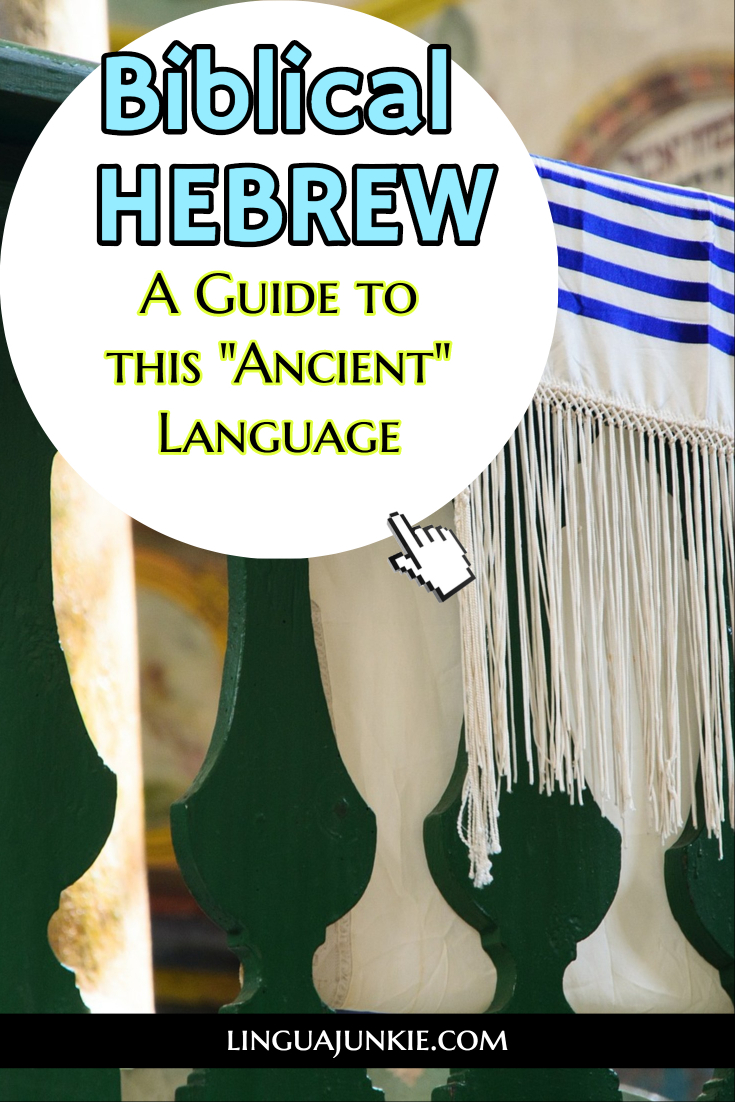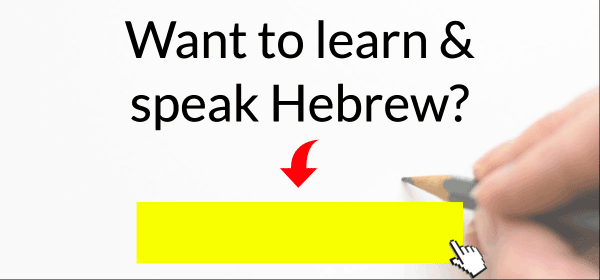Hello Junkies,
Looking for Biblical Hebrew lessons?
In this comprehensive guide, you’ll learn a bit about grammar, vocab and the unique points of Biblical Hebrew. Sounds good? Good.
Read on!
Biblical Hebrew Lessons – A Guide to this “Ancient” Language

Oh, by the way…
If you want to learn and speak Hebrew…
May I suggest a Hebrew learning program? It’s called HebrewPod101.com. If you’ve always wanted to speak the language, you can and will with their Audio/Video lessons by Hebrew teachers. You get over 500+ lessons, tons of apps, study tools and PDF eBooks. Click here to get a free lifetime account.
1. What is Biblical Hebrew, you ask?
Great question!
Biblical Hebrew (or classical Hebrew) is the language of the Old Testament of the Bible and the archaic form of Modern Hebrew.
How old is it?
The earliest archeological records show that Biblical Hebrew was used for writing and speaking from around 1300 B. C. until 300 B. C. For many decades after, it only existed in the Bible and in the texts explaining it.
People mostly used it for prayer and for reading the Old Testament of the Bible.
Biblical Hebrew and Modern Hebrew share the same alphabet and writing system.
So if you know Modern Hebrew you can easily read any Biblical text.
But, it would be much more difficult for you to understand it. In order to do this, it is necessary to learn all the peculiarities of Biblical Hebrew, like grammar, vocabulary and syntax.
Learning Biblical Hebrew will help you read the Bible (“Tanakh”) in its original form.
You can read their translated versions, but, unfortunately, it is impossible to transfer all the details and peculiarities in translation.
Let’s move on to the next Biblical Hebrew lessons.
2. So, what’s the difference between Biblical and Modern Hebrew?
A. Vocabulary
Let’s talk about words.
Modern Hebrew has been modified to suit the needs of modern life. A ton of new words and terms were created to name new things that didn’t exist 3,000 years ago.
For example, words like: computer, bicycle, car, telephone, molecule and so on.
Biblical Hebrew uses words that have more specific theological meanings and are either no longer used, or have a new, more “modern” meaning.
There are only about 8,000 words in the Bible. It is clear that in the spoken and written language of that period, there were much more words, however they were not used in the Bible. The biblical vocabulary, though limited, is the most important basis for the new Hebrew vocabulary.
In other words, if you want to learn Biblical Hebrew, you should focus on the words!
B. Grammar
So, what about Biblical Hebrew grammar and modern grammar?
There are three tenses in Modern and in Biblical Hebrew. The Past, Future and Present. But, they are formed according to different rules.
Biblical Hebrew tends to have many composite and blended words that consist of 2 and more words. For example:
- Did you know?
- Biblical Hebrew: ?הֲיָדַעְתָּ (hayadata?)
- Modern Hebrew: האם ידעת? (haim yadata?)
- You leave me
- Biblical Hebrew: תַּעַזְבֵנִיָ (taazveni)
- Modern Hebrew: תעזוב אותי (taazov oti)
C. Syntax
Unlike Modern Hebrew where the Subject comes first, in Biblical Hebrew the verbal predicate is often followed by the subject.
Example:
- Biblical Hebrew: “וְהָיָה כִּי-יִרְאוּ אֹתָךְ הַמִּצְרִים……”
- Modern Hebrew: “המיצרים יראו אותך……”
Here are some examples of words that are different in Modern and in ancient Hebrew:
Biblical Hebrew | Phonetics | Modern Hebrew | Phonetics | English |
אֲנֹכִי | Anoh’i | אני | ani | I / me |
לֵאמֹר | leemor | בקול רם | Bekol ram | Out loud |
כֹּה | ko | כך | Kah’ | In this way… |
Let’s move on to some more Biblical Hebrew lessons.
3. Who learns Biblical Hebrew nowadays?
People in Israel speak only Modern Hebrew nowadays.
However Biblical Hebrew is also learned in some cases:
- For prayer. Most of the Jewish prayers are in Biblical Hebrew, but there are Modern Hebrew prayers as well.
- Biblical Hebrew is studied by Rabbis both in Israel and outside the country. It is necessary for Rabbis to be able to read and understand the Holy texts and the texts explaining it.
- Kids study the Old Testament of the Bible at school. That is why most Hebrew speakers who grew up in Israel know the basics of Biblical Hebrew.
4. Basic Biblical Hebrew grammar rules
If you’re interested in Biblical Hebrew lessons, you’ll want to cover grammar.
Let’s do just that.
Most words in Biblical Hebrew are formed from a three-consonant root or a derived verbal stem that is used to express grammatical voice.
(For example: חדל, זעק, אשמ, בצר, נדד and many others)
The numerals are often positioned ascendingly, for example:
- שְׁלֹשִׁים וּמֵאָה מִשְׁקָלָהּ (can be literally translated as: thirty and one hundred weight) = 130
A verb that stands before two subjects corresponds to the first subject in gender and number.
The use of singular with plural words, for instance:
- חֲמִשִּׁים אִישׁ בַּמְּעָרָה (can be literally translated as: fifty man in the cave). The word “אִישׁ” (ish – man) is used in singular instead of “אנשים” (anashim – people / men).
– Possessive pronouns and nouns are very often combined into one word like in the following examples:
Biblical Hebrew | Phonetics | Modern Hebrew | Phonetics | English |
עַבְדּוֹ | avdo | העבד שלו | heaved shelo | His slave |
יָדְךָ | yad’h’a | היד שלך | Hayad shelh’a | Your hand (to a male) |
יְרֵכִי | yereh’i | הירך שלי | hayareh’ sheli | My thigh |
Questions in Biblical Hebrew usually begin with the questioning “ה.“
Here are a few examples:
- Biblical Hebrew: “?הרצחת וגם ירשת” (haratzah’ta vegam yarashta?)
- Modern Hebrew: “?האם רצחת וגם ירשת” (haim ratzah’ta vegam yarashte?)
- Biblical Hebrew: השומר אחי אנכי?” ” (hashomer ah’I anoh’i?)
- Modern Hebrew: האם שומר אחי אני?” ” (haim shomer ah’I anoh’i?)
Biblical Hebrew often uses the “direction ה”at the end of words indicating place or direction, for instance:
- Biblical Hebrew: “ארצה“ (artza)
- Modern Hebrew: אל הארץ”” (el haaretz)
- English: to the country
- Biblical Hebrew: “מצרימה“ (mitzraima)
- Modern Hebrew: למצרים”” (lemitzraim)
- English: to Egypt
Biblical verbs in the past tense usually begin with the letters “וי“, like in the following examples:
- Biblical Hebrew: “ויאמר” (vayomar)
- Modern Hebrew: אמר”” (amar)
- English: he said
While Biblical verbs in the future tense usually begin with the letter “ו“:
- Biblical Hebrew: “ונתתי” (venatati)
- Modern Hebrew: אתן”” (eten)
- English: I will give
And there you go!
i hope you enjoyed the Biblical Hebrew Lessons in this article.
If you’re interested in MORE Hebrew lessons, click below.
- How to Learn Hebrew in 5 Minutes a Day (STUDY TOOLS inside)
- 10+ Hebrew Audio Lessons & MP3 for Learners
- Hebrew Learning Programs for Brand NEW Learners
– The Main Junkie
P.S. Done with reading articles and want to learn Hebrew for real?
Okay! I recommend HebrewPod101.com — an online learning program with audio/video lessons made by real teachers. You can learn to speak, read and write, AND take your lessons on any device.
